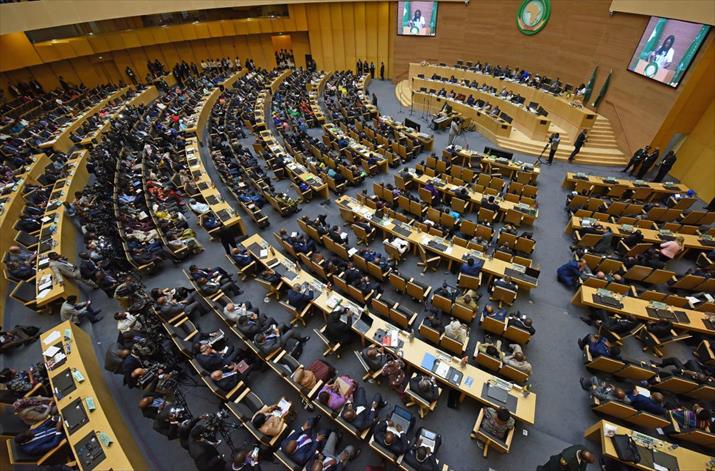|
||||||||||
| Home Nation World Business Opinion Lifestyle ChinAfrica Multimedia Columnists Documents Special Reports |
|
||||||||||
| Home Nation World Business Opinion Lifestyle ChinAfrica Multimedia Columnists Documents Special Reports |
| Africa |
| Harnessing Demographic Dividends |
| Optimism at AU Summit for youth development in Africa |
| By Charles Onunaiju | VOL.9 August 2017 ·2017-08-04 |

THE history of all developed economies and even the emerging ones have been their abilities to harness human resource into capital and use its diverse multiplier effects to create value chains spanning all other resources categories. In addition, this process unleashes outcomes that include a rise in national economic aggregates and more importantly, improved quality of living standards for citizens. It is because of the foundational implications of human resources that many developed and emerging economies invest in strategic sectors such as education and health and other key initiatives of capacity building. Even for nations with less natural resource endowment, the massive investment in human resource development and capacity building fills the deficit gap between the two, enabling development and growth.
Africa's greatest challenge is to harness its abundant human resources and translate them into capital for transforming economies and societies for the benefit of all. Africa's huge natural resource endowment has not been translated into appreciable aggregates to spur sustainable and inclusive development, largely because of a deficit of the requisite manpower to explore and harness it to the needs and priorities of respective national goals.
It is against this background that the core theme of this year's 29th Ordinary Session of the Assembly of African Union (AU), Harnessing the Demographic Dividend Through Investment in Youth, is both instructive and epochal.
This is so, because youths in Africa have featured prominently in the past as cannon fodder used as violent thugs and touts to settle political scores among political parties in contention for power.
This enduring abuse of youthful energy and strength has taken its toll, over the years in the critical deficit of manpower in the construction of contemporary African economies. The realization of the dynamism and resourcefulness of youth may have come against the background of a falling profile of natural resources as a key catalyst for growing economies of the respective states in Africa. The recognition of the centrality of the youth and the description of it as potential demographic dividend, worth investing and harnessing, speaks volumes of the rethink in strategic corners of influence and power in Africa.

It is worth welcoming. The embarrassing scenarios in recent times where African youths are drowning in droves in the Mediterranean Sea, while struggling to cross over to Europe for a better life that exists only in their imagination, would have set off alarm bells in several African capitals and also, at the AU headquarters in Addis Ababa. The commitment to harness the demographic dividend and invest in the youth is historically late.
But it is also a welcome relief in recognizing Africa's precious asset, whose transformational prospects were first seen in the phenomenal energy with which the African youths drove the anti-colonial struggles in the early and middle of the last century. However, the report to the AU's 29th Ordinary Session by Chadian President Idriss Deby Itno on the lead agenda of the summit, which also discussed migration and employment, put the subject of investments in the youth high on the agenda, which it actually deserves.
In conclusion and the way forward, the 43-page report on the subject presented at the session stated that "harnessing the demographic dividend in Africa presents a strategic opportunity to realize the aspirations and goals of Agenda 2063." It also affirms that "Africa has been committed to transforming its large youth population into a development asset."
Commending the theme of the summit, the report states that "building on previous decisions of the African Union Assembly on youth empowerment, the 2017 theme of Harnessing the Demographic Dividend Through Investment in Youth has the potential to have far-reaching implications that would address all the key issues that governments have had to contend with, and change development trajectory of Africa toward building the Africa we want."
This is very eloquent and brimming with the usual optimism, but the crux of the matter is translating the fine letters of the document into implementable policy outlines and frameworks. The political will of harnessing Africa's demographic dividends through investments in the youth must be found, because time is of essence. In addition, the core strategic international partners of Africa, like China, are waiting in the wings to integrate with the continent's practical initiative to move its youth population to the center of its strategy to harness economies of scale, ramp up its competitiveness in the global market place, and advance on the path of inclusive growth and development.
The youth challenge goes beyond the critical imperatives of skill acquisition and employment, as important as that may be, to creating a congenial environment through which the youth would exercise their creative imagination and thrive. If this does not happen, whatever skills the youth may acquire may be lost in brain drain, whereby the youth would look to more promising and encouraging environments to practice their skills. Investments in youth can also subsist effectively in a social milieu, where relative stability and security is guaranteed.
China, Africa's all-weather and enduring partner, has blazed a considerable trail in creating an environment of scientific and technological innovations, where youth have brought their enormous creativity and energy to bear. Yet for all its successes and accomplishments, China constantly renews itself as infinite opportunities, through which its youth and even outsiders can attain the pinnacles of their dreams.
Youthful energy and creativity can turn Africa around, unleashing the legendary potential, which has endured years of incubation; but the policy gap of fine rhetoric and implementation must be closed.
The 29th Ordinary Session of the AU Assembly in July has created a spring of optimism about the prospects of investing in the youth as a way of harnessing Africa's demographic dividend. But this time, it must not be withered by the hurricane of the winter.
(The author is the director of the Center for China Studies, Nigeria)
|
||||
| About Us | Contact Us | Advertise with Us | Subscribe |
| Copyright Beijing Review All rights reserved 京ICP备08005356号-5 京公网安备110102005860号 |